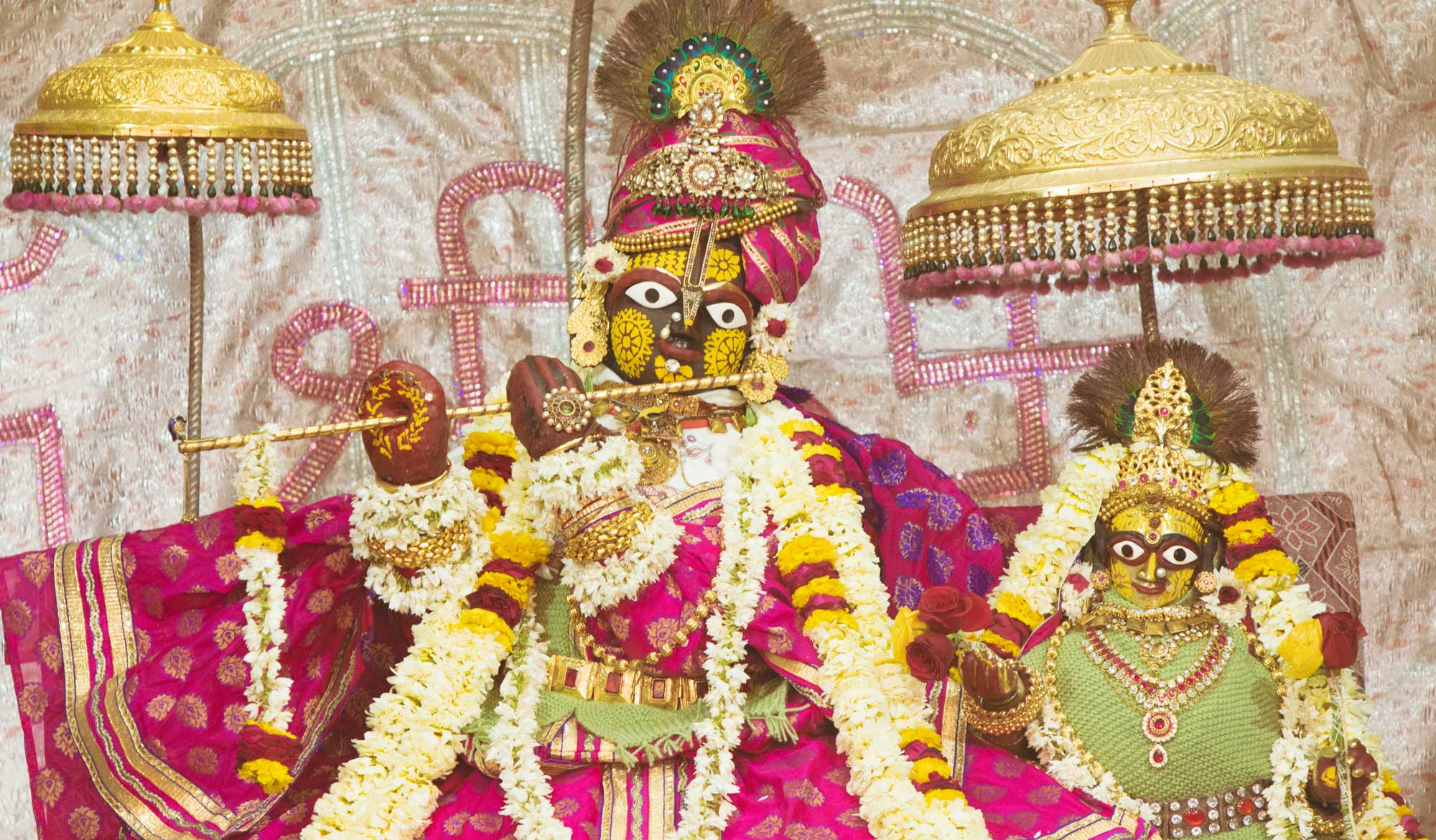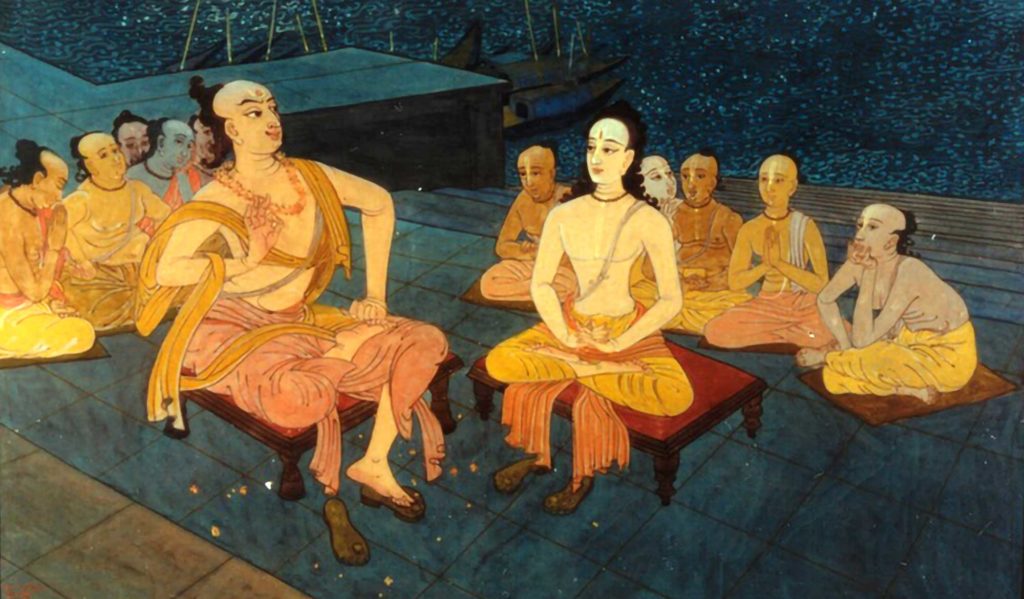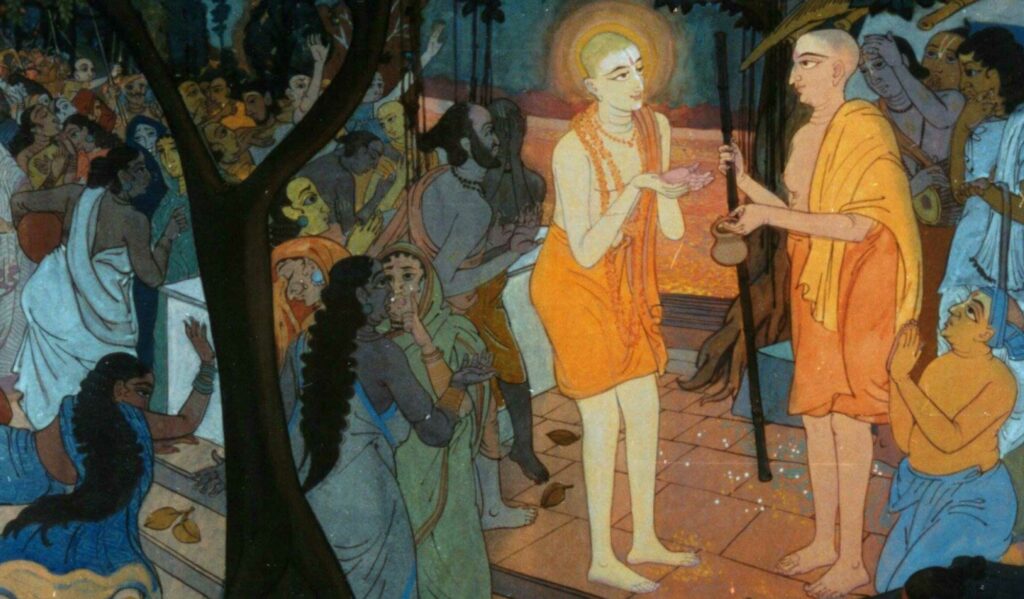Overview
In 'The Ontological Position of Śrī Śrī Rādhā-Govinda', Śrīla Śrīdhara Mahārāja describes the glories of Śrī Śrī Rādhā-Govindadeva, and the special characteristic of Govinda within the Gauḍīya sampradāya in relation to Śrīla Rūpa Gosvāmī Prabhu and in comparison with Gopīnātha and Madana-mohana. This article is based upon a talk given in January 1982.
In my childhood I had some mystical transcendental desire for Vṛndāvana and Rādhā- Kṛṣṇa. As a boy I visited several times a respectable temple of Rādhā-Govinda near our village, where my grandfather used to read Bhāgavatam every Kārttika month. In my childhood, even when I was six perhaps, I visited that temple and I remember that I saw with some mystic reverence in the temple and the śrī-mūrti. I still remember the mystic conception I had about Rādhā-Govinda there. But consciously, due to some moral consideration, I could not adjust with kṛṣṇa-līlā in Vṛndāvana. But now Mahāprabhu has given this to me.
My regard for Mahāprabhu has taken me to Rādhārāṇī and at present my highest centre in future is Rādhārāṇī. But my present centre is Mahāprabhu. Through Mahāprabhu, I came to find who was the fittest preacher of Mahāprabhu, and then I came to my Guru Mahārāja. The first centre was Mahāprabhu and it came suddenly when I was reading in the fourth year class. When I was about the age of twenty-three, Mahāprabhu suddenly appeared in my heart and captured me. Otherwise, I was born into a Smārta family – Nyāyikas of the highest type. Nyāyikas means logicians. Smṛti, Purāṇa and Nyāya – these three things were there. But I had some sort of acquisition from my previous life because I had the tendency to become a sādhu – more so than to become a householder in my future life. I felt this from my childhood. I had much attraction for the life of a sādhu, an inner demand – but not of any particular shape. Mahāprabhu gave me the real shape. He is my saviour, and through Him only I could come to Vṛndāvana.
After the disappearance of our Guru Mahārāja, there was some disturbance in the maṭha between the trustees and I left and went to Vṛndāvana. But my aim was to take shelter in my last days here in Koladvīpa – aparādha-bhañjana pāṭha. I passed the holy month of Kārttika in Vṛndāvana, and circumambulated Govardhana Girirāja every day. When the month was finished, I took govardhana-śilā from there and came to pass my last days of life here. When I was coming, I had a thought in my mind that, “I am going to take shelter in Navadvīpa-dhāma for my whole life, but the real Master of the dhāma is Nityānanda Prabhu, so I must go to Nityānanda Prabhu, to take His permission, to have His grace, and then I shall go to Navadvipa.” So I went to Ekacakra, the birthplace of Nityānanda Prabhu, where his śrī-mūrti is being worshipped regularly, and there, when I fell flat before Him, I got some sort of inspiration. Anyhow, from there I came with that govardhana-śilā and in some rented house I lived for about two years. Then some of my godbrothers secured this land for me, and I came here in a cottage in 1942 and I used to go on taking the Holy Name and worshiping govardhana-śilā.
Gradually I felt that Mahāprabhu should be installed here, and with the help of some of my friends I installed Mahāprabhu’s śrī-mūrti. According to the line of our Guru Mahārāja, the Deities of Mahāprabhu-Rādhā-Govinda should be there. So following that order, I installed also Rādhā-Govinda. Our Guru Mahārāja installed Mahāprabhu and Rādhā-Govinda almost everywhere, meaning that Mahāprabhu is combined Rādhā-Govinda. Mahāprabhu means Rādhā-Govinda. Svarūpa Dāmodara has given us a śloka about the ontological nature of Mahāprabhu –
rādhā-kṛṣṇa-praṇaya-vikṛtir hlādinī-śaktir asmād
ekātmānāv api bhuvi purā deha-bhedam gatau tau
caitanyākhyam prakaṭam adhunā tad-dvayaṁ caikyam āptaṁ
rādhā-bhāva-dyuti-suvalitaṁ naumi kṛṣṇa-svarūpam
“The loving affairs of Rādhā and Kṛṣṇa are divine manifestations of the Lord’s internal pleasure-giving potency. Though Rādhā and Kṛṣṇa are one in Their identity, They separated Themselves eternally. Now these two personalities have once more united in the form of Śrī Caitanya. I bow to Him, who has manifested Himself with the mood and complexion of Śrīmatī Rādhārāṇī although He is Śrī Kṛṣṇa Himself.”
Who is Mahāprabhu? Just as Rādhārāṇī has Her most intimate friend Lalitā, who knows the real heart of Rādhārāṇī – so too Lalita’s avatāra, Svarūpa Dāmodara, knows fully who Mahāprabhu is. Therefore he has given this acquaintance with Mahāprabhu – who He really is from the ontological side.
We cannot say whether winter is first, or summer is first, or rainy season is first, or autumn is first – it is moving in a cyclic order. If I begin from winter, then next comes summer. If we begin from summer, then afterwards comes winter. Similarly, the līlā is eternal – Kṛṣṇa and Mahāprabhu. In Kali-yuga He is coming as Mahāprabhu Śrī Caitanyadeva and in Dvāpara-yuga, He is coming as Kṛṣṇa – but time is an eternal factor in nitya-līlā. Here we have taken that Satya-yuga is first, then Treta-yuga, then Dvāpara-yuga, then last, Kali-yuga. Again, after Kali-yuga comes Satya-yuga.
Satya, Treta, Dvāpara, Kali – in a cyclic order. Kali-yuga is at the beginning, then comes Satya-yuga next, then Treta, then Dvāpara. So whether Mahāprabhu is first, or Kṛṣṇa is first is unquestionable. It is revolving in a cyclic order.
Svarūpa Dāmodara says that first Rādhā-Govinda are combined, and we see that in Dvāpara-yuga. They are separate for their līlā. Sometimes They are combined for līlā, and sometimes They are separate for līlā. In this way it is passing through in a cyclic order. The Whole who was combined and one – Rādhā-Govinda – later we find to be separated in vṛndāvana-līlā. Both vṛndāvana-līlā and navadvīpa–līlā are eternal. In the highest eternal ontological quarter, we find līlās of both types. In the Vṛndāvana compartment, we find that They are having Their pastimes together. Rādhā-Govinda are separate there. And in gaura-līlā we find Rādhā-Govinda combined, and both of Them try to distribute Themselves to others. What was combined in their own section, in gaura-līlā we find that same rasa is being distributed to others. Audārya and mādhurya – the two specific characteristics of two līlās, and two avatārīs. Both of them are avatārī – the source of all avatāras. The highest conception of the ontological aspect of the Absolute, but two phases. In one, They are tasting Their own sweetness of Their own līlā. In another place, They are both trying to distribute it to the other souls. They are of two types – of the same rasa and the same degree. This is the difference.
Our Guru Mahārāja wanted to show this in the installation of the Deities. The highest order of worship is here – Mahāprabhu, who is giving the rasa, and Rādhā-Govinda with Their paraphernalia which They are tasting within Their own circle. That highest order of sweetness is being distributed by Mahāprabhu Himself in His līlā. They are of the same level, the same dignity and the same high position. To represent this, Guru Mahārāja has taken this method in arcana, as favourable for his preaching about Rādhā-Govinda in Vṛndāvana.
Guru Mahārāja installed his Deities in Śrī Caitanya Maṭha, where They are named Guru-Gaurāṅga-Gāndharvā-Giridhārī. And here, in Śrī Caitanya Sārasvata Maṭha, by remembering his holy feet, I have given the name ‘Guru-Gaurāṅga-Gāndharvā-Govindasundara’. Govindajī has a special characteristic in our sampradāya. Govindajī was worshipped and installed by Rūpa Gosvāmī. In Govindajī’s praṇāma we find:
dīvyad-vṛndāraṇya-kalpa-drumādhaḥ
śrīmad-ratnāgāra-siṁhāsana-sthau
śrīmad-rādhā-śrīla-govinda-devau
preṣṭhālībhiḥ sevyamānau smarāmi
“In a temple of jewels in the forest of Vṛndāvana under a desire tree, Rādhā-Govinda sit upon a jewelled throne and are served by Their most confidential associates. I offer my respects unto Them.”
We find that in Vṛndāvana, Kṛṣṇa has been installed in three phases. First there is Rādhā-Madana-mohana,
Who represents sambandha-jñāna, which with whom we are ultimately connected in our final liberated position. Rādhā-Madana-mohana are alone – no friends of Kṛṣṇa, no friends of Rādhārāṇī – this is Madana-mohana. Rādhā-Madana-mohana was worshipped by Sanātana Gosvāmī who is the ācārya of sambandha–jñāna, with whom we are connected.
Then we come to Govinda of Rūpa Gosvāmī. Govinda means abhidheya – how to worship Him. That direction was given by Rūpa Gosvāmī and he installed Govindajī. What type of worship is there? Rādhā-Govinda are with some servitors, the sakhīs and mañjarīs etc. They are serving Rādhā-Govinda. In that sort of posing He has been installed by Rūpa Gosvāmī. Not that they are alone, but they are being worshipped. We are more concerned with that. Our superior Vaiṣṇava gurus and pārṣadas are worshipping Rādhā-Govinda, and we can have our teachings and our training from that idea. That is more suitable for us. So, I have tried my best to connect the vigraha here in our maṭha with Govindajī. A select group is worshipping Rādhā-Govinda and we shall have their example and instructions, and accordingly we shall try to enter into their group. Then, the third is Rādhā-Gopīnātha. And that is –
śrīman rāsa-rasārambhī vaṁśī-vaṭa taṭa sthitaḥ
karṣan veṇu-svanair gopīr gopīnāthaḥ śriye stu naḥ
“Śrī Gopīnātha who created the divine mellow of the rāsa dance, stands on the shore of Vaṁśī-vaṭa, attracting the attention of the gopīs with the sound of His flute. May Rādhā-Gopīnātha shower Their blessings upon us.”
Prayojana-tattva – rāsa–līlā. When Gopīnātha is showing His rāsa–līlā, then He is in a general public mādhurya–rasa group. That is Gopīnātha. He is the Lord of the gopīs in general. He invites all the gopīs with the sweet sound of His flute and He begins the rāsa–līlā, where all are accommodated. Anyone with the gopī type aspiration to worship Kṛṣṇa may have some place there – in a very general assembly of the gopīs where Kṛṣṇa plays with them. But that is a general rāsa-līlā. There, Rādhārani, Candrāvalī and other various groups are represented – it is the most public. That rāsa–līlā is so public that Rādhārāṇī had to leave that, and Kṛṣṇa ran after Her, leaving the rasa. But we are rūpānugas and our need is the special group, in the group of Rādhārāṇī. We appreciate them all, but our special affinity is towards the group of Rādhārāṇī and they are being worshipped by our superiors. I like that the most and therefore I brought here Śrī Govindadeva of Rūpa Gosvāmī.
Especially my Gurudeva – before his departure, he took me to his side and wanted me to sing the song of Rūpa Gosvāmī, Śrī Rūpa-mañjarī-pada. And following that, I have installed here Govindajī – Rādhā-Govindajī…Gāndharvā-Govindasundara. This is my attitude in the installation of the Deity here that I have presented to you.
Related Articles and Books
- Śrī Dāmodara Kathā – The History of Rādhā Dāmodara Temple (Book)
- Kṛṣṇa-tattva (The Fundamental Reality of Śrī Kṛṣṇa) by Śrīla Bhaktisiddhānta Sarasvatī Ṭhākura
- The Ontological Position of Śrī Śrī Rādhā-Govinda by Śrīla Bhakti Rakṣaka Śrīdhara Deva Gosvāmī
- Śrī Govardhana Pūjā by Śrīla Bhakti Rakṣaka Śrīdhara Deva Gosvāmī
- Śrī Narasiṁha Caturdaśī by Śrīla Bhakti Rakṣaka Śrīdhara Deva Gosvāmī
- Śrī Śrī Rādhā Kṛṣṇa – The Fountainhead of All Tattvas by Śrīla Bhakti Pramoda Purī Gosvāmī
- Kṛṣṇa – The Supreme Vedāntist by Śrīla A.C. Bhaktivedānta Swami Prabhupāda
- Dāsa Gosvāmī and the Unique Position of Govardhana by Śrīla Bhakti Gaurava Narasiṅgha Mahārāja
- The Worship of Govardhana by Śrīla Bhakti Gaurava Narasiṅgha Mahārāja
- Śrī Kṛṣṇa Janmāṣṭamī by Śrīla Bhakti Gaurava Narasiṅgha Mahārāja
- Questions and Answers on Baladeva Tattva by Śrīla Bhakti Gaurava Narasiṅgha Mahārāja
- The Worship of Lord Narasiṁha by Śrīla Bhakti Gaurava Narasiṅgha Mahārāja
- The Dawn of the Age of Love? by Śrīla Bhakti Gaurava Narasiṅgha Mahārāja
Further Reading
- Śrī Kṛṣṇa Saṁhitā by Srila Bhaktivinoda Thakura (Book)
- Impersonal Spirituality and Transcendental Spirituality by Śrīla Bhaktivinoda Ṭhākura
- Servitorship to Kṛṣṇa by Śrīla Bhaktivinoda Ṭhākura
- The Glories of Puruṣottama Māsa by Śrīla Bhaktivinoda Ṭhākura
- Identifying the Supreme Object by Śrīla Bhaktivinoda Ṭhākura
Pilgrimage with Swami Narasiṅgha – Part 7: Keśī Ghāṭa
Continuing with our pilgrimage series, this week Śrīla Narasiṅgha Mahārāja takes us to Keśī Ghāṭā where he tells us about Madhumaṅgala’s meeting with the Keśī demon, what Keśī represents, and how Śrīla Prabhupāda almost acquired Keśī Ghāṭa. Mahārāja also narrates his own experience. This article has been adapted from a number of talks and articles by Narasiṅgha Mahārāja.
Prema Dhāma Deva Stotram with the Narasiṅgha Sevaka Commentary – Verses 61-65
In verses 61 to 65 of 'Prema Dhāma Deva Stotram', Śrīla Śrīdhara Mahārāja narrates the pastime of Śrī Caitanya at Caṭaka Parvata In Purī and explains how the scriptures produced by Brahmā and Śiva are ultimately searching for the personality of Mahāprabhu who is merciful too all jīvas, no matter what their social position.
Prabhupāda Śrīla Sarasvatī Ṭhākura’s Visit to Ayodhyā
With the forthcoming observance of Śrī Rāma Navamī, we present 'Prabhupāda Śrīla Sarasvatī Ṭhākura’s Visit to Ayodhyā' written by Śrīla Bhaktisiddhānta Sarasvatī Ṭhākura Prabhupāda from The Gaudīyā magazine, Vol 3. Issue 21/ In December 1924, after visiting Benares and Prāyāga, Sarasvatī Ṭhākura visited the birth-site of Śrī Rāmācandra in Ayodhyā.
Śaraṇāgati – The Only Path to Auspiciousness
In this article, 'Śaraṇāgati - The Only Path to Auspiciousness', Dhīra Lalitā Dāsī analyses the process of śaraṇāgati (surrender) beginning with śraddhā (faith). She also discusses the role of śāstra and the Vaiṣṇava in connection with surrender.
Pilgrimage with Swami Narasiṅgha – Part 7: Keśī Ghāṭa
Continuing with our pilgrimage series, this week Śrīla Narasiṅgha Mahārāja takes us to Keśī Ghāṭā where he tells us about Madhumaṅgala’s meeting with the Keśī demon, what Keśī represents, and how Śrīla Prabhupāda almost acquired Keśī Ghāṭa. Mahārāja also narrates his own experience. This article has been adapted from a number of talks and articles by Narasiṅgha Mahārāja.
Prema Dhāma Deva Stotram with the Narasiṅgha Sevaka Commentary – Verses 61-65
In verses 61 to 65 of 'Prema Dhāma Deva Stotram', Śrīla Śrīdhara Mahārāja narrates the pastime of Śrī Caitanya at Caṭaka Parvata In Purī and explains how the scriptures produced by Brahmā and Śiva are ultimately searching for the personality of Mahāprabhu who is merciful too all jīvas, no matter what their social position.
Prabhupāda Śrīla Sarasvatī Ṭhākura’s Visit to Ayodhyā
With the forthcoming observance of Śrī Rāma Navamī, we present 'Prabhupāda Śrīla Sarasvatī Ṭhākura’s Visit to Ayodhyā' written by Śrīla Bhaktisiddhānta Sarasvatī Ṭhākura Prabhupāda from The Gaudīyā magazine, Vol 3. Issue 21/ In December 1924, after visiting Benares and Prāyāga, Sarasvatī Ṭhākura visited the birth-site of Śrī Rāmācandra in Ayodhyā.
Śaraṇāgati – The Only Path to Auspiciousness
In this article, 'Śaraṇāgati - The Only Path to Auspiciousness', Dhīra Lalitā Dāsī analyses the process of śaraṇāgati (surrender) beginning with śraddhā (faith). She also discusses the role of śāstra and the Vaiṣṇava in connection with surrender.








